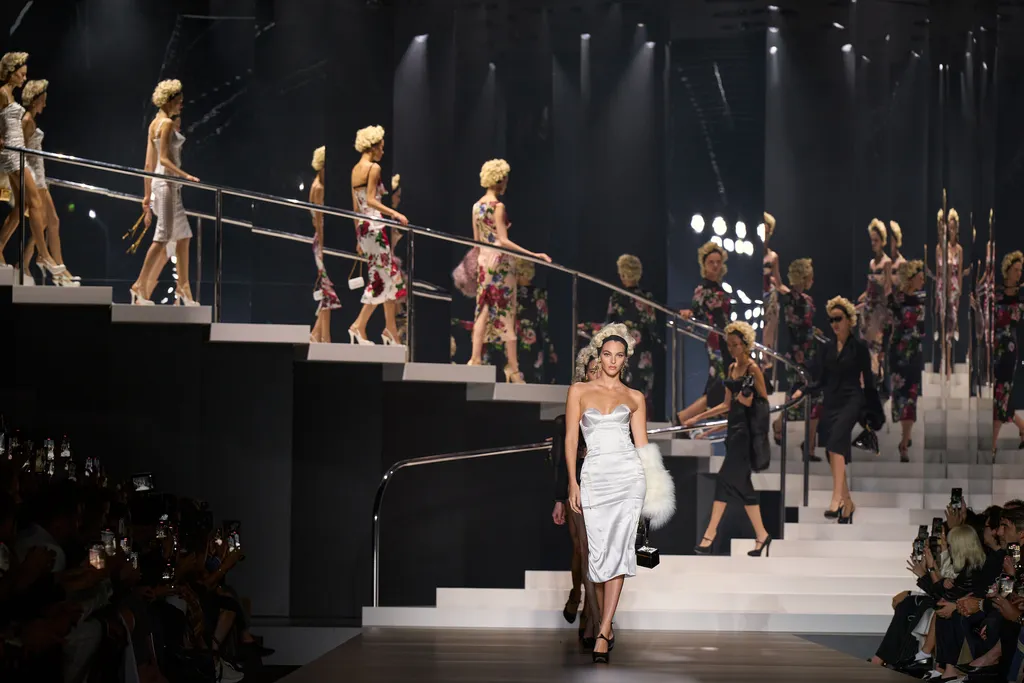This season, Milan Fashion Week moved one day earlier due to a small schedule change that provided much-needed breathing room to an already jam-packed schedule. “I’m extremely happy with this collaborative effort by the four major players in the fashion industry,” stated Carlo Capasa, president of Camera della Moda, the organisation that organised the event for the week. “Given its calendar of over 200 appointments, [we] had been asking for an extension of the Milan Fashion Week for a while.”
On September 17, the afternoon session of Roman house Fendi kicked off with Kim Jones taking a look back at the 1920s, the decade in which the house was established. Next up was Marni, where Francesco Risso showcased a collection of unique glamour that referenced mid-century silhouettes and turned out to be one of the week’s highlights. While Prada’s varied collection honoured individual flair, other notable exhibits included Gucci, Versace, Ferragamo, Bottega Veneta, and Dolce & Gabbana, where the designers paid homage to Madonna, who was seated front row.
Those that did not show this season included Giorgio Armani, which will exhibit in October in New York as part of the 90th birthday festivities of the eponymous designer, and Tom Ford, whose new creative director Haider Ackermann will make his debut the following year. Blumarine, where David Koma will debut his first collection the following season, and MSGM, which had a more exclusive presentation at its headquarters, were also absent.
Here, fashion features editor Jack Moss of Wallpaper* reports live from Milan, selecting the highlights of Milan Fashion Week as it unfolds.
The best of Milan Fashion Week S/S 2025
Bottega Veneta
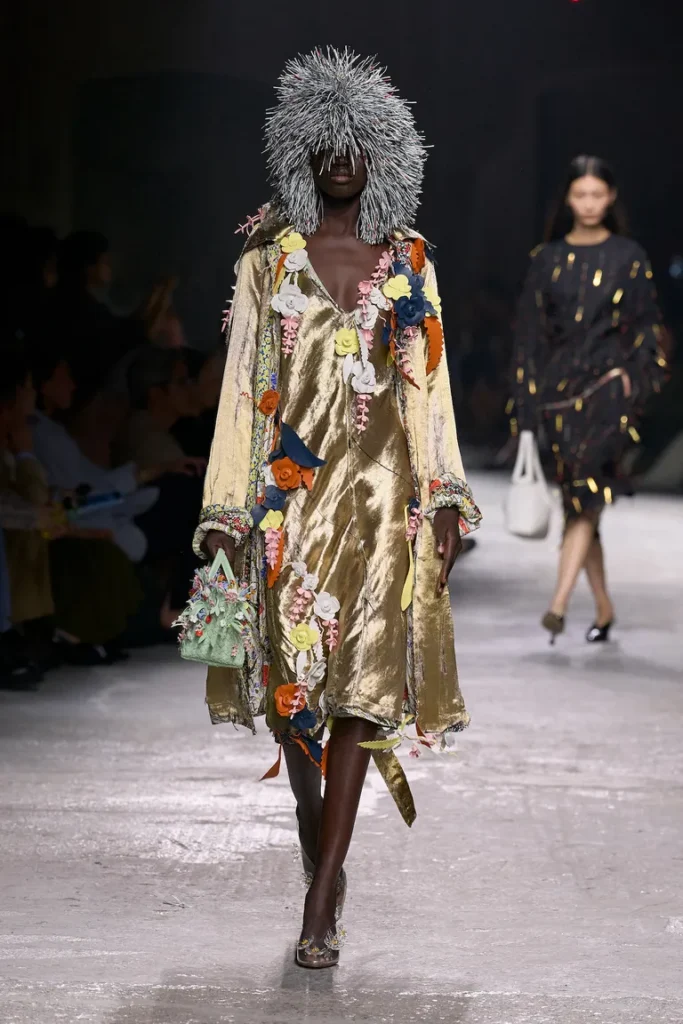
Matthieu Blazy stated, “I was interested in the power of “wow,” following his most recent Bottega Veneta catwalk show, which served as the Milan Fashion Week finale this season. The moment in Steven Spielberg’s iconic coming-of-age film ET when the title extraterrestrial hides himself in a wardrobe full of colourful plush toys is something he had been thinking about, he continued. “The wonder you have as a kid when you try on your parent’s clothes; it’s almost primal,” he elaborated. He replicated the setting in the showspace, a disused warehouse, using bean bag chairs made of leather that were shaped like various animals, including foxes, cats, and killer whales, in place of regular seating.
It prepared the audience for an array of pure play and imagination that paired with the deft, opulent takes on everyday clothing that have come to define Blazy’s style—here, blown-up corporate tailoring, grocery bag-inspired handbags, T-shirts and jeans with deliberate creases—were happy, almost childlike flourishes, like tasselled wigs, animal motifs, or striking bursts of colour. “This collection embodies the delight of finding, observing, and dressing,” he declared, adding that the idea for the collection originated from his vision of a suit-wearing parent dropping off his child at school while toting their vibrant pink backpack on their shoulder. “Maybe the previous season was more reflective,” Blazy went on. However, we also require beauty. We require happiness. We keep playing because we need this time to ourselves.
Dolce & Gabbana
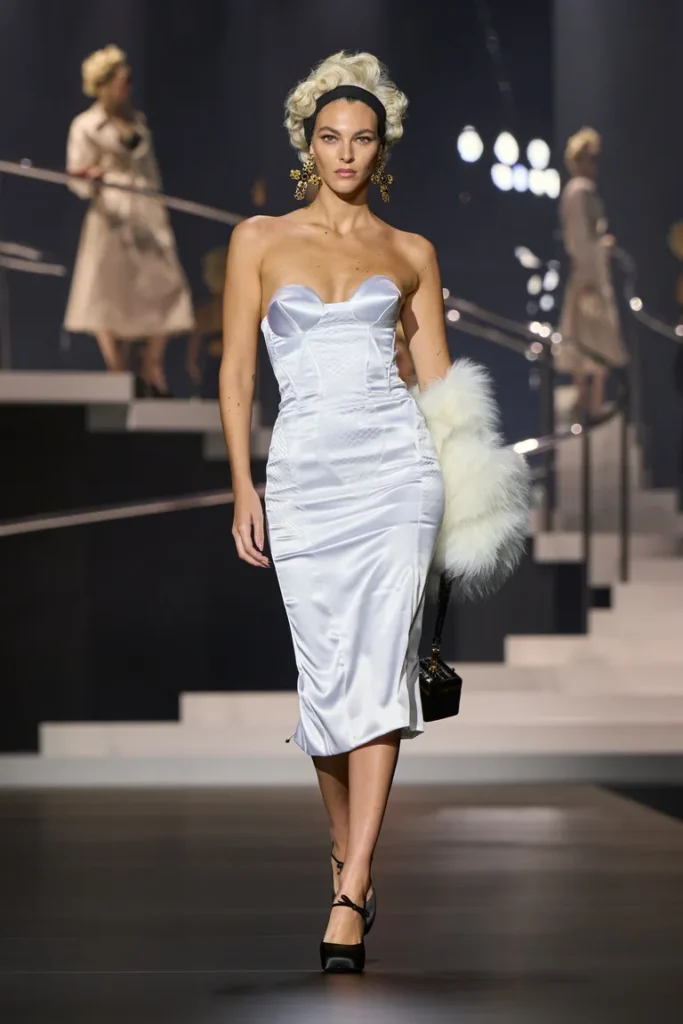
Since the first day of Milan Fashion Week, there have been whispers that Madonna will be attending Dolce & Gabbana’s most recent runway show. These rumours were virtually verified when the artist shared on Instagram that she had arrived in the city the day before the presentation. She did indeed appear, dressed in a black veil and crown by Dolce & Gabbana, as the crowd of a thousand people seated at the Metropol venue—where Stefano Gabbana and Domenico Dolce host their runway shows every season—and her entrance sparked an unplanned standing ovation as fans rushed to capture the star on camera.
The show opened to a frisson of excitement, paying homage to the queen of pop with models dressed in curly blonde wigs, pointed bra tops (a nod to modern designer Jean Paul Gaultier) and lace-up corsets that brought back memories of the artist’s “Blonde Ambition” era of the early 1990s. It was the kind of mega-watt moment that Milan, or indeed London and New York, had not yet experienced. Our icon has always been Madonna. “Many things in our lives have changed because of her,” they remarked, alluding to their strong partnership that began in 1992 when they created costumes for her “The Girlie Show” tour. Finally, a moved Madonna, who just wrapped up her most recent tour, “Celebration,” which featured her best hits, hugged the designers as they made their parting bow, bringing the entire Metropol stadium to their feet once more.
Ferragamo
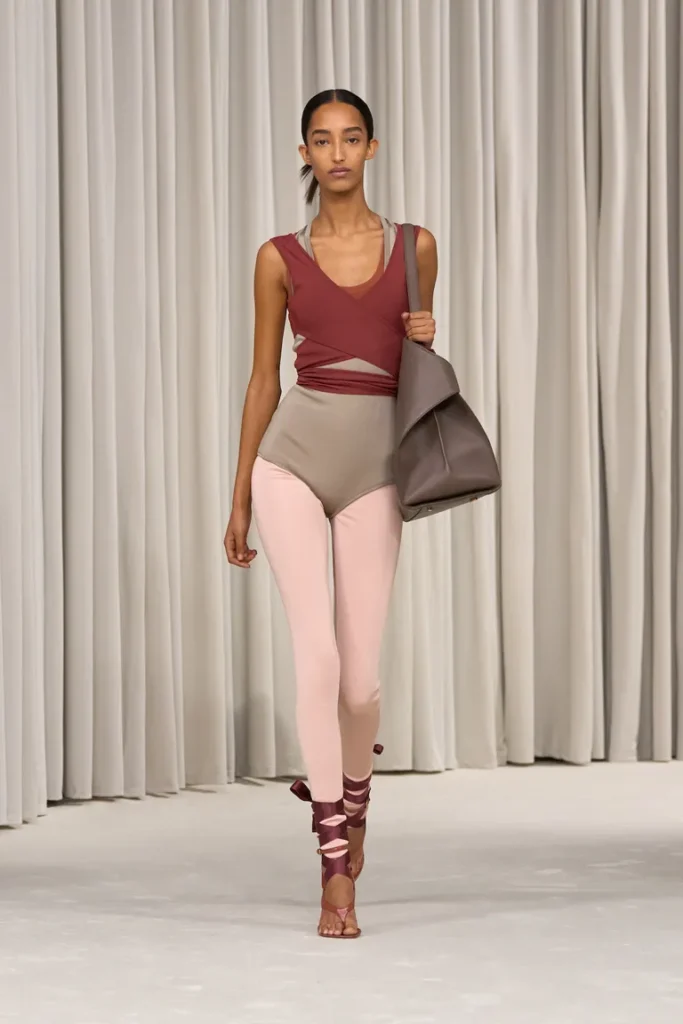
Maximilian Davis set up his most recent collection for Ferragamo on a circle runway that was lavishly covered in an off-white carpet and encircled by curtains of the same colour (which were closed as the show started to fully enclose the audience in the enormous, cocoon-like area). Given that Davis looked towards two clients of Salvatore Ferragamo, the founder of the house, ballet dancer Rudolf Nureyev and American choreographer Katherine Dunham—the trailblazing dancer known as the “matriarch and queen mother of Black dance”—it appeared to be a sign of a softening direction for the British designer this season.
Davis invoked the dancewear tropes for a collection that was more entrenched in the practice room than the blousy splendour of the stage, signalled by a classic Ferragamo depiction of a ballet shoe on the invite. In fact, a number of ensembles featured layers of leotards, dance tops, and leggings, and the ribbon-tie closures on shoes evoked the style of ballet slippers.
The designer claimed that the loose, beachside dress codes of his own Caribbean heritage were referenced by the designer. Elsewhere, silhouettes were louche and oversized or wrapped around the body, giving homage, according to Davis, to Nureyev’s 1980s wardrobe. Fabrics also had a worn-in quality to them, as evidenced by the frayed edges of shorts and handbags and opening creases in outerwear. “I’ve always included various historical eras in my work, times when I can identify with myself,” said Davis, deftly integrating Ferragamo’s illustrious past into the present. I searched for parallels with Ferragamo, and this brand’s appeal is that there are a tonne of relatable stories. Every shoe has a meaning of its own and a backstory.
Gucci
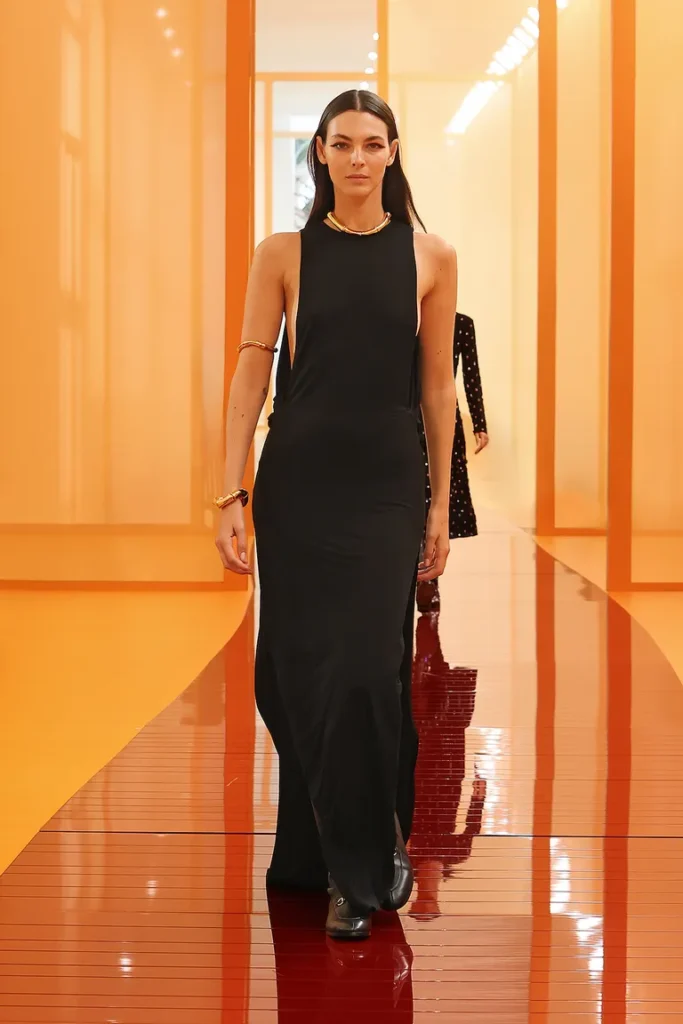
Enzo Mari’s perpetual calendar for Danese Milano, with its curved plastic design reprinted in Ancora red—the deep, oxblood tone that has run throughout his term as creative director thus far—was included on the invitation for Sabato De Sarno’s most recent Gucci presentation. De Sarno stated that the collection was about “a precise moment in time… a moment to seize to live to the fullest… a moment the sun dives into the sea at the end of the day.” This was why the item choice was deliberate. Because of this, the semi-circular runway, which passed through the Triennale museum in Milan, a shrine to design, echoed the colours of the twilight as it moved through the many “rooms,” from yellows and oranges to Ancora crimson.
De Sarno used this as inspiration to create a collection that celebrated the fleeting pleasures in life. From headscarves and vivid designs inspired by the house’s horsebit motif to shimmering metal paillettes and delicate lace, the clothes were meant to be worn on a daily basis but also evoked moments of pleasure. “Casual grandeur that takes shape through my obsessions… always with an irreverent attitude,” was how he put it. The models exited the runway dancing, while De Sarno, who appeared to capture the carefree, upbeat spirit of the collection, bounced after them. The designer of a self-assured outing said, “A year later, this collection shows an accomplished journey of construction.” “I have built my ideas for Gucci moment by moment.”
Missoni
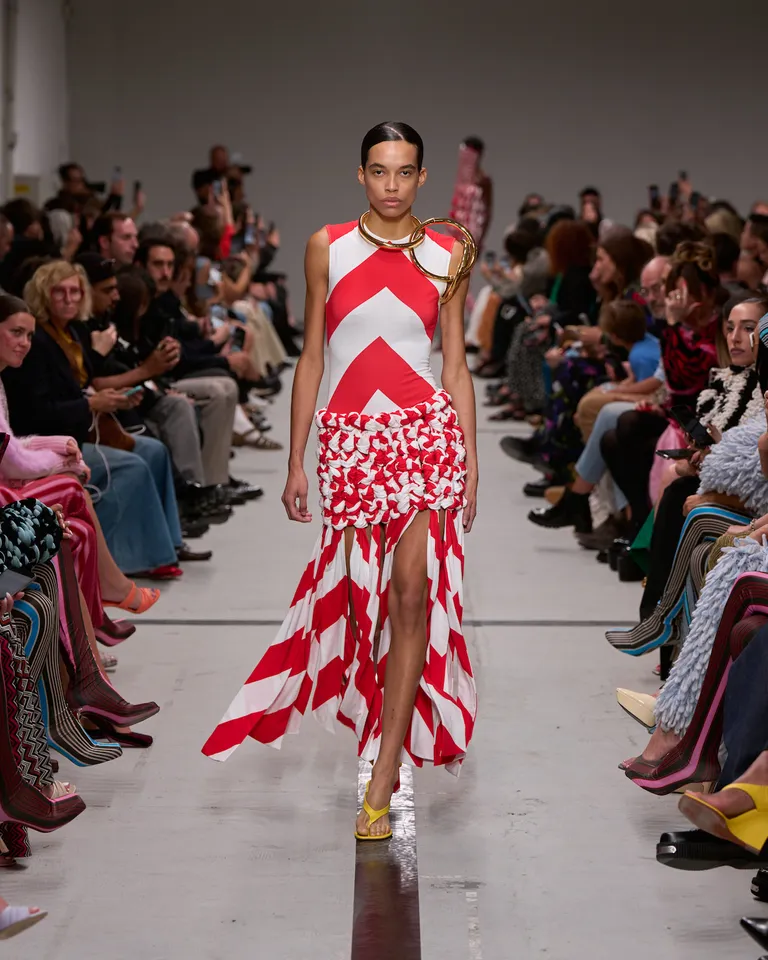
Since Missoni’s establishment in 1953, graphic flourishes and a free-spirited approach have been essential components of the Italian knitwear business, Filippo Grazioli has established himself as a designer unafraid of the bright and colourful. Although he did name-check the modernist wire sculptures of American artist Ruth Asawa, Grazioli claimed that this season he was instead thinking about “the energy of chaos through the endless dance of colours and shapes” rather than a set inspiration point.
This mostly meant focussing on Missoni’s distinctive zig-zag, which could be blown out into chevrons that adorned skirts and overcoats or emerge on what he termed a “millefeuille” the front of a top—a three-dimensional layered zig-zag that protruded forth in hues of red, white, and black. Meanwhile, tassels’ vibrant fronds, spiky knits, or a fluffy fabric that gave the impression the figure had just come out of a bubble bath offered a sense of textural play. It resulted in a free-flowing, instinctual collection that maintained Milan’s experimental spirit this season.
Sportmax
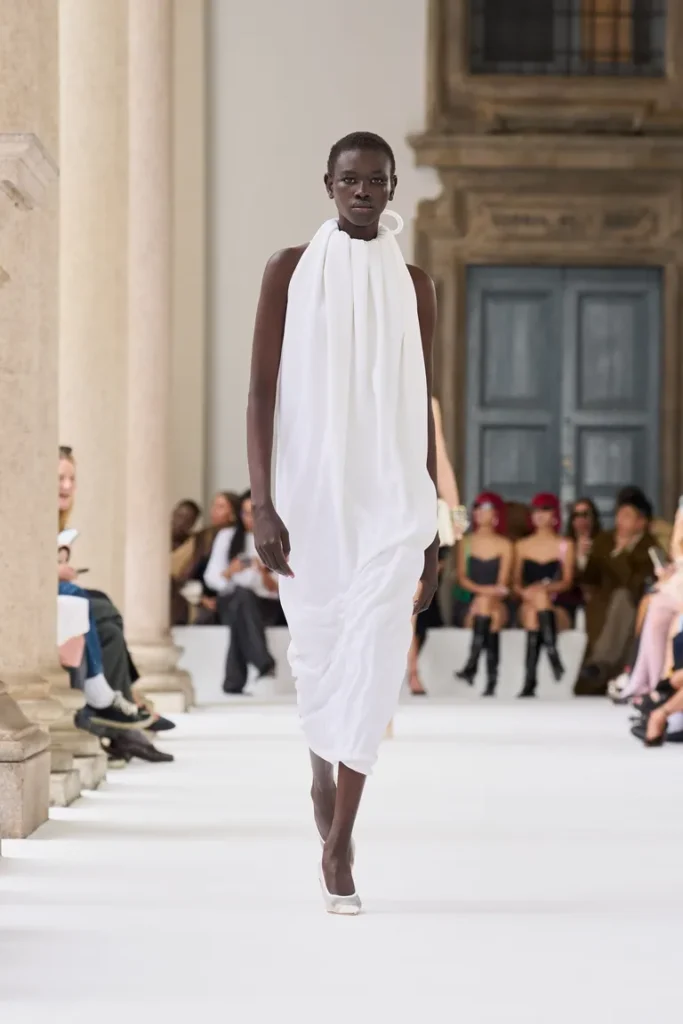
The central courtyard of Milan’s storied Pinacoteca di Brera art gallery served as a striking setting for Sportmax’s most recent exhibition, made more so by the way yards of vivid, optical white carpet blanketed the whole space. It was an odd trick, almost like a snowflake effect, but it also gave the ornate 18th-century room a futuristic gleam. The Sportmax team loves these unusual pairings, and this vibe persisted throughout the collection. Sculptural box-shaped bra tops, trousers with hems cut, blazers and overcoats with nipped waists, and other moments of razor-sharp precision coexisted with fluid and embellished pieces, such as beaded dresses, clattering crystals hidden beneath sheer fabric, and sensual gowns that deftly wrapped around the body.
It went perfectly with the overall vibe of the season, which sees designers paying tribute to personal flair and expressing a new eclectism. As a result, the design team claimed that this was an assortment of unadulterated intuition—an experimental method of operation that has always proved successful.
Tod’s
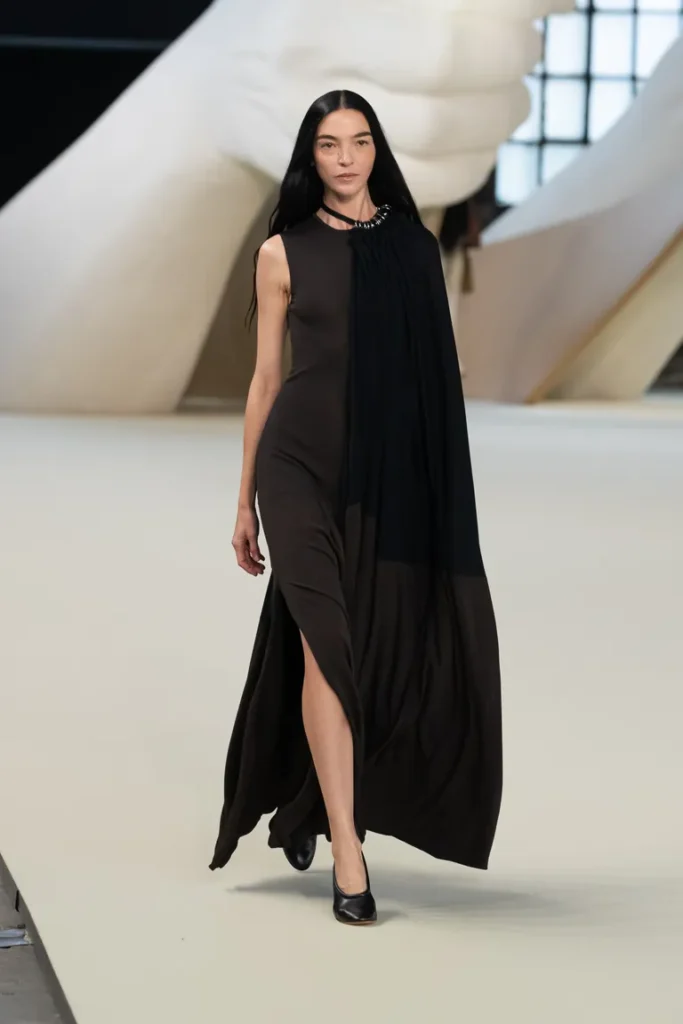
‘Artisanal Intelligence’ was the whimsical title of Matteo Tamburini’s sophomore collection for Tod’s, which was backdropped by a gigantic installation by Italian sculptor Lorenzo Quinn created for the occasion in a derelict warehouse on the outskirts of Milan. It was made consisting of a massive pair of hands and twisted loops of “leather,” which the models—a stellar cast that included Mona Tougaard, Naomi Campbell, and Mariacarla Boscono—walked through before circumnavigating the immense room. In order to capture a sense of Mediteranean ease, Tamburini skilfully avoided the heavy or the overdone, opting instead to wear lightweight poplin cotton shirts and parkas, narrow-strap sandals, and gently draped silhouettes in tones the designer described as shifting between warm “stone, sand and bronze” and “the vibrant colours of Italian landscapes: the earth’s red, the sea’s blue, and the meadows’ green. Along with a new take on the Gommino driving shoe, it featured a row of metal rings as embellishment (a motif that resurfaced on the neckline of Boscono’s draped layered gown). Ladylike handbags in faux ostrich and mock-croc met structured, elongated bucket-style bags, the latter featuring an exquisite metal band along their closure. Guests were reminded of the labour-intensive process and human beings involved in each piece as they passed the rows of workers hand-stitching the Gommino shoe on their way out.
Emporio Armani
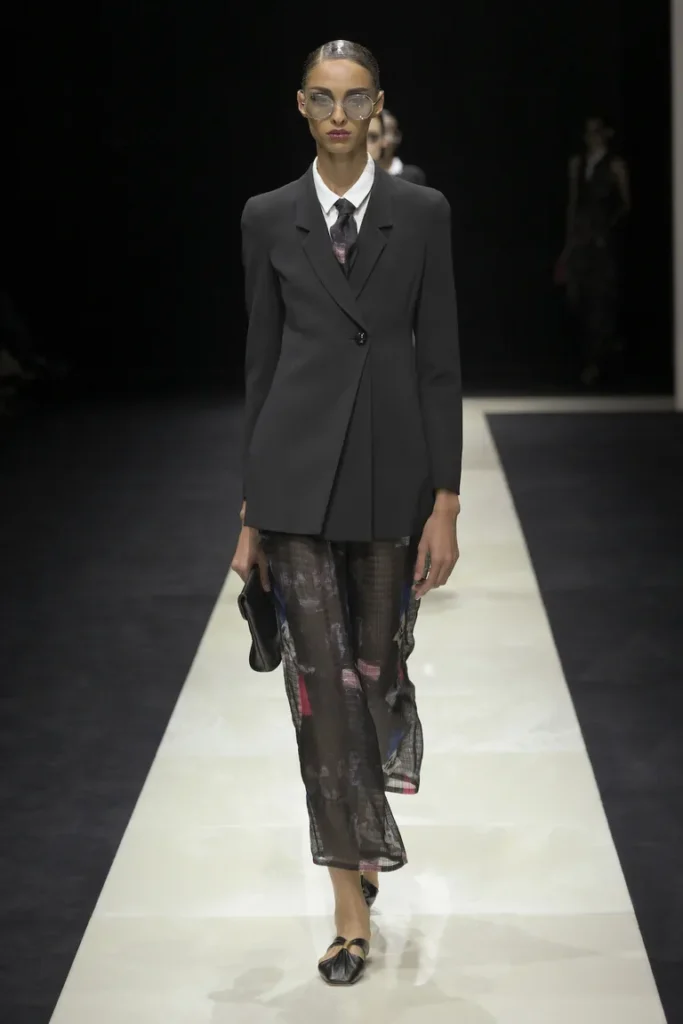
Emporio Armani took up the brand’s mantle in Milan since Giorgio Armani did not hold a show this season. Instead, the collection will be displayed in New York in October as part of the Italian designer’s ongoing 90th birthday celebrations. Emporio is experiencing great success, as demonstrated by the celebration that took place immediately following the show. Guests were ushered next door for champagne, spritzers, and dancing in honour of the renovations and reopening of the Emporio Armani store in Milan, which continued until the wee hours of the morning. The theme of the exhibition, “Future Perfect,” was similarly upbeat, with Mr. Armani referencing his most well-known ensemble—the men’s blazer and tie.the latter, large and languid (it’s a look that’s gaining popularity, thanks to Anthony Vaccarello’s A/W 2024 Saint Laurent menswear collection, which brought to mind the American Gigolo dressed in Armani). Here, he created a women’s version, which the notes called as “an elegant and provocative declaration of gender equality.” He contrasted it with flowing, feminine silhouettes in light-weight materials, which, like all of his summer collections, were inspired by a spirit of escape and travel. The soft, light version of the boxing boot was the footwear that continued the feeling of relaxation. Like previous seasons, Mr. Armani’s team, which included Silvana Armani, director of womenswear design, and Leo Dell’Orco, head of menswear design, shared the runway for his farewell bow.She is also the niece of the designer. The cheers were as thunderous as usual.
Moschino
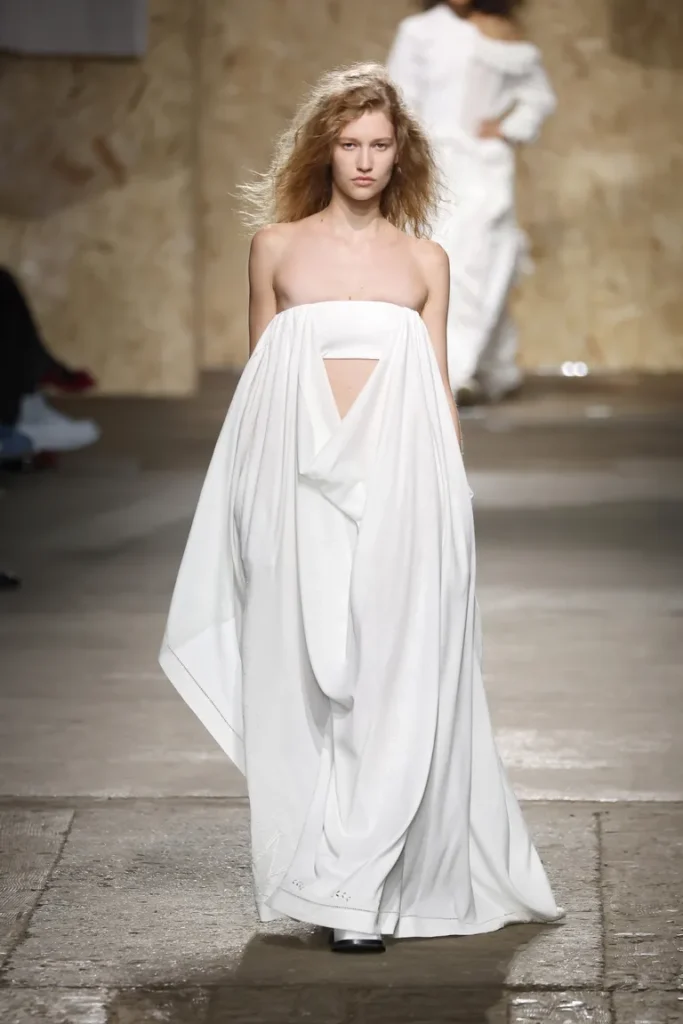
Using the basic white bed sheet as a starting point for a reflection on the creative process and how we use clothing to define who we are, Adrian Appioloza launched his sophomore collection for Moschino (fittingly, the Milan warehouse was hung with clothes lines of washed white linen). The opening looks, which saw the “ordinary made extraordinary,” captured an air of adolescent experimentation as they were twisted into gowns, transformed into trench coats, or scrawled with biro drawings. In keeping with the theme, the opening looks were paired with whimsical handbags shaped like tea bags and laundry detergent bottles.
The vibrant collection that followed saw Appioloza take cues from a range of subcultures, including bikers, the grunge movement, and Buffalo, the British collective from the 1980s that Terry Jones, the creator of i-D magazine in London, referenced in bold typographical graphics. Judy Blame, a member of Buffalo, also contributed original archival jewellery to the collection (Trust Judy Blame, established in the late creative’s memory, also worked with Moschino on reissued pieces). Three gowns that were sewn onto the backs of otherwise simple black suits may have been the collection’s high point, as the exhibition came to an end. Like the brand’s founder, Franco Moschino, Appioloza confidently refined his vision for the house, which embraces the whimsical but is rooted in the real world. These stunning and strange pieces were a fitting finale to the collection.
Prada
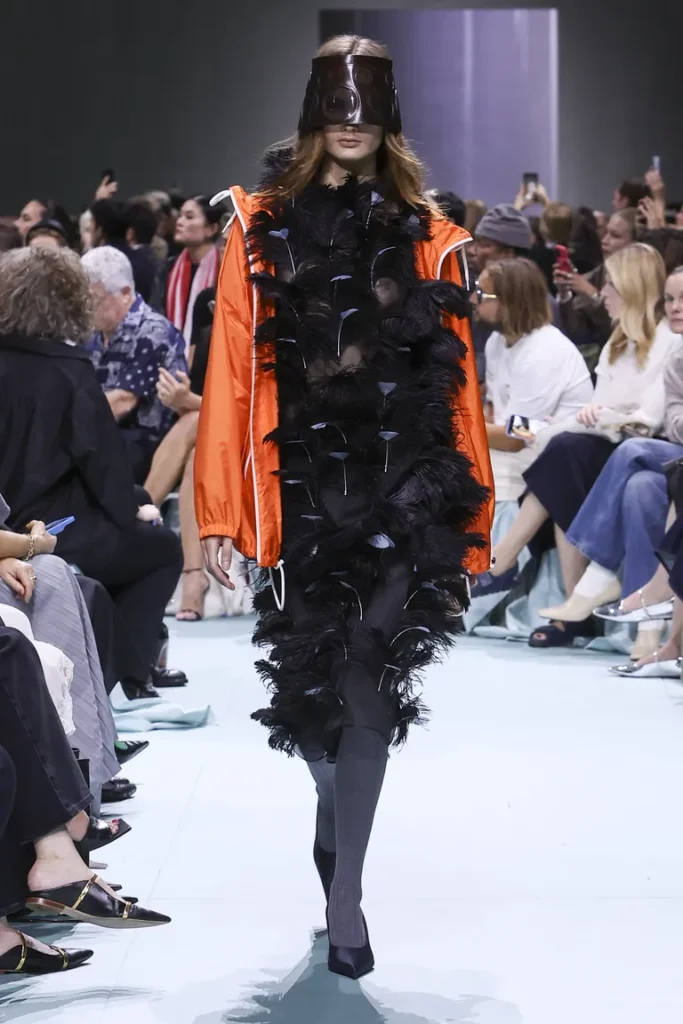
This season’s OMA-designed Prada show set was more understated than previous, consisting of a succession of serpentine seats wrapped in satin sheets that were split and raw at the ends. This was a change from the menswear show’s “fairytale ravescape.” However, it turned out to be somewhat of a red herring. Because this collection tapped into a trend that has already been prevalent this season: a new eclecticism that favours unique expression and intoxicating juxtapositions above neat thematics.As stated in the collection notes, this was, in fact, “a rejection of the derivative and expected.” Co-creative directors Miuccia Prada and Raf Simons claimed that this was a reaction to the concept of the internet algorithm, which provides information that is constantly customised to the reality of each individual. “We are algorithm driven,” Mrs. Prada remarked succinctly behind the scenes. “We like the things that other people tell us to like.”
Rather, the designers embraced what they termed the “unpredictability” of human nature—the inclination to continuously express and dress differently depending on our mood. “We live in an era of limitless information, powered by algorithms, where everyone sees the world through a curated version of the present,” Mrs. Prada continued. “Our goal was to initiate a conversation sparked by this idea, not to criticise it,” the statement reads. We analyse its essential ideas and come to our own conclusions: choice, unpredictableness as a barometer of human innovation, and Prada for every person.As the house put it, “infinite options proffer infinite opportunities”; no two looks in this collection were same, and conflicting features, primarily a change between the prim and ladylike and the surreal and fetishistic, made for an inspiring collection.
Hence, there were intentionally skewiff shirts and dresses, as well as trompe l’oeil elements (such as ‘fur’ collars and belts overlaid onto trousers) that referenced the men’s collection that debuted in June. The two also discussed how they dressed with ‘clothes that have lived a life, that are alive in themselves’. Ideas clashed in other places: a worn-out long-sleeved T-shirt with a full-length satin skirt embellished with appliqué flowers; a feathered dress paired with a neon-colored anorak; a traditional Argyll jumper paired with a rough leather skirt covered with hanging metal rings.Massive eyelets were used as ornaments, and headscarves with integrated sunglasses or visor-like hats were popular. The effect was as disorienting and unsettling as quickly scrolling through the Instagram Explore page.
According to Simons, “We considered each person as a superhero, with their own power, their own story.” That conveys the sense of change—whether it is by your behaviour, your practice, or the things you wear. All of these are ways to communicate a message about your own power and strength. They have the power to change how you see yourself.
Max Mara
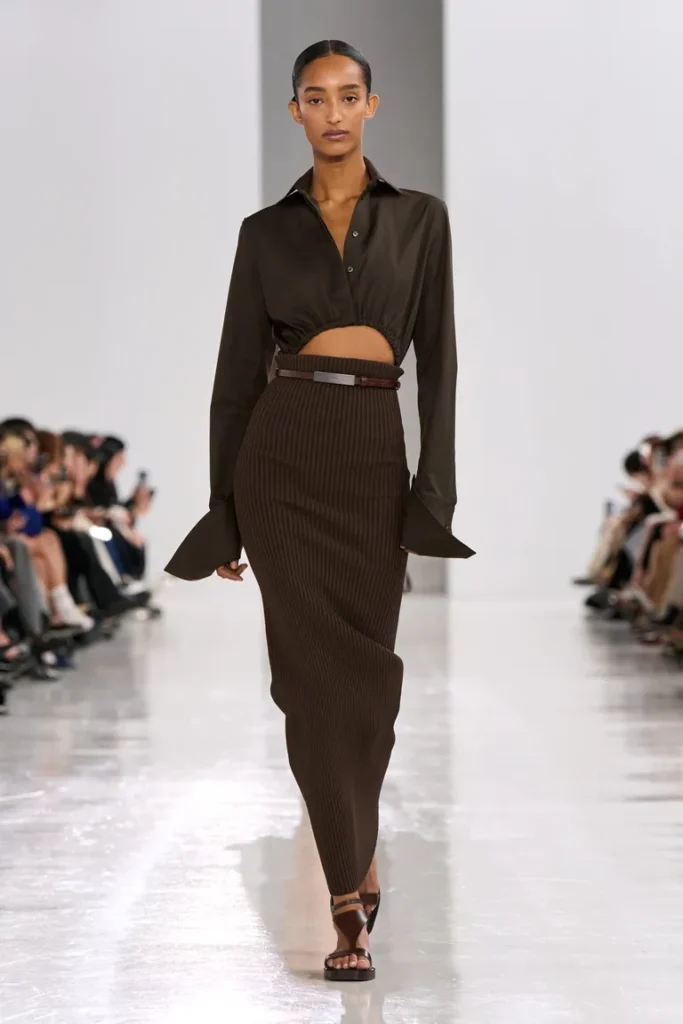
In his twenty years as creative director of Max Mara, British designer Ian Griffiths has built up an extensive and varied archive of historical women, many of whom are unknown or underappreciated, from which he takes inspiration. This season, he cast his net back to antiquity, focussing on the 4th century and the significant lecturer and teacher Hypatia of Alexandria, a rare female voice in ancient Egypt and a mathematician and astronomer. It inspired Griffiths to create the “Science and Magic” collection, which honours mathematicians for their ability to “reduce the messy old universe to a series of sleek equations.” The same could be said of Griffiths’ approach to clothing, which streamlines dressing with elegant yet useful suggestions for a woman’s wardrobe.
There was a full-length, lightweight take on the traditional single-breasted overcoat that looked fantastic, as well as pristine white shirts, flowing ribbed knits, and slightly oversized blazers. As for the origami-like folds that appeared on the waistlines of dresses and jackets, Griffiths compared them to the work of Hypatia, a Pythagorean who concentrated on the proportions of triangles. Max Mara is another dressmaker who creates intricate lines and folds.
Jil Sander
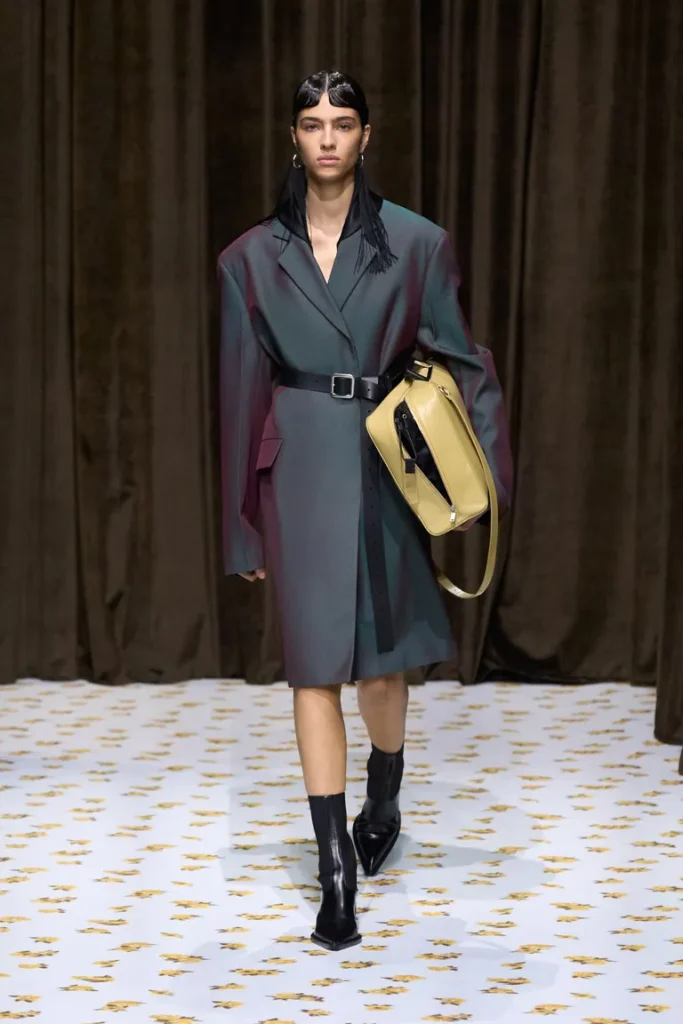
The latest Jil Sander collection by Lucie and Luke Meier was inspired by Canadian photographer Greg Girard. It was shown in darkly lit hallways with brown velvet curtains set up in a warehouse on Milan’s northern outskirts. Specifically, the “colour and emotional gradients” of his images, which have mostly concentrated on the way Asian cities are changing and the lives of people living on the fringes, from Shanghai, where he has lived since 1998, to Hong Kong’s “hidden nightlife.” The pair’s melancholy outing was enhanced by their highly varied outfit choices, which referenced observed sights in cities after dark and were meant to imply both “romantic seediness” and “urban sophistication.”
The husband and wife team claimed to have drawn inspiration for the collection’s eclectic mood from “whatever sparked their imagination, from any time or place.” The ensemble featured iridescent tailoring, cowboy denim, vinyl overcoats embellished with flowers, riffs on the bowling shirt, doiley-like crochet, and ribbed knits with twisting beaded edges. The result was an unexpectedly freeing collection that inspired “a tender desire to be beautiful, glamorous, and pleased.” Girard’s images, which featured a lit-up car at sunset and constellations of flowers mirrored by those that showed over the white carpeted floor, appeared across clothing as a finishing touch.
No. 21
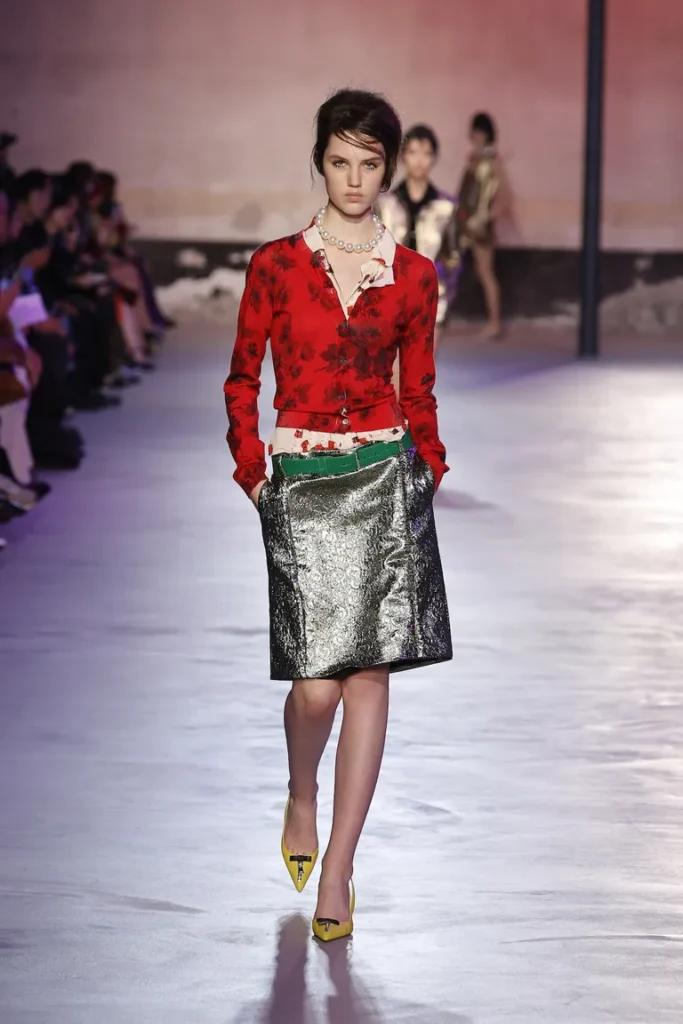
Alessandro Dell’Acqua claimed that the upbeat vibe of the 1960s served as inspiration for his most recent No. 21 collection. Karlheinz Weinberger, a Swiss photographer, is renowned for his ability to capture the rebellious and subcultural scenes of the time, especially in Europe where Americana had an influence. As a result, designers working with denim and leather have long used Weinberger’s images as a point of reference. However, Dell’Acqua, whose work has always captured a fierce, dishevelled glamour, did not intend for this to be a literal reinterpretation; rather, she aimed to evoke the creative spirit of the young women, who frequently found rebellion in unexpected, mismatched combinations that went against their parents’ traditional dress codes.
Thus, there were skewiff flowery cardigans paired with pearls and dishevelled hair, dazzling brocade skirts, fuzzy leopard-print collars, pointed heels with a chequerboard print, and billowing sheer layered dresses that showed off vibrant undergarments underneath. In other places, tailored silhouettes and buttoned swing coats brought back memories of the distinctive 1960s styles. “I borrowed their inventiveness, which I think originated from their desire to mix various trends and styles, modi e modi,” Dell’Acqua remarked. “Day by day, they reinvented themselves.”
Marni
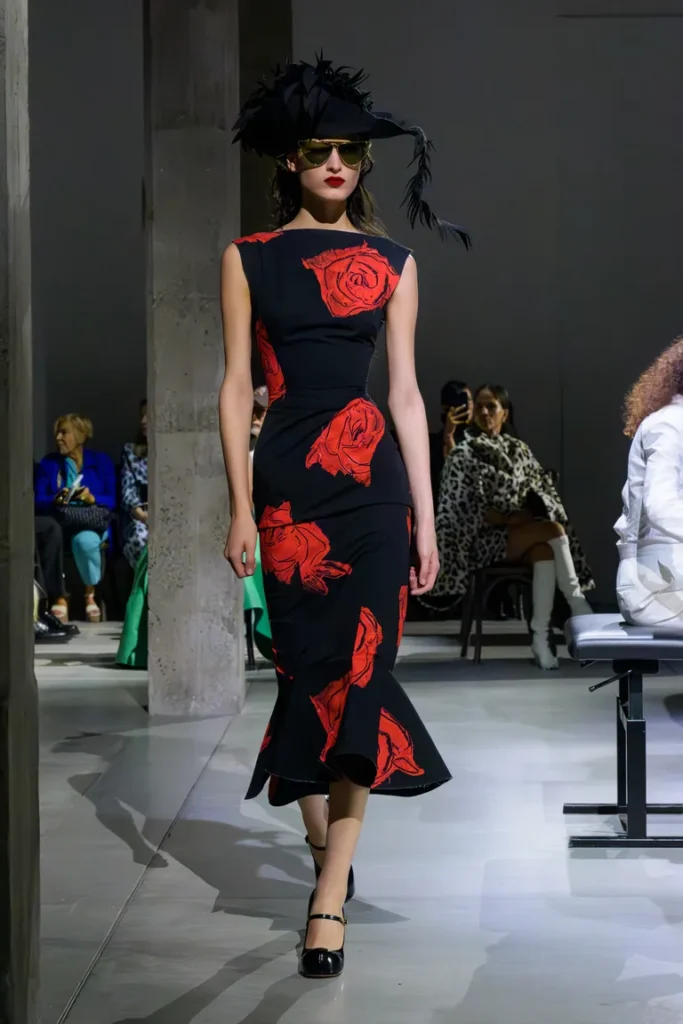
Francesco Risso, the designer of Marni, returned to Milan last season after a world tour that stopped in New York and Tokyo. The designer decided to remain in Milan for S/S 2025. As it happened, this was as near to home as it gets: The presentation, which Risso chose to have held in Marni’s offices on Viale Umbria, took place in a large concrete hall completely covered with wooden bistro seats arranged at different angles. When the lights came up at the end of the show, the models had actually been following the three pianos in the centre, which were being led by musician Dev Hynes, as they emerged in groups of three and threaded through the seats on seemingly random courses.
It provided a dramatic backdrop for the designer’s ground-breaking collection, which rejected the unrefined creativity of the previous seasons in favour of an experiment with glitz and polish in the peculiar manner of Risso. It mostly focused on plays on midcentury silhouettes: opera coats were draped softly over the shoulders, narrow-waisted dresses were embellished with floral prints, and dramatic headwear was adorned with “feathers” that resembled cut-out paper (a play on the feather boa was also created using a similar technique). In the meanwhile, broad tailoring, leather jackets and high-waisted pants with a nod to 1960s greasers were examples of a macho style.
Men and women’s makeup featured arched eyebrows in the Divine style, with the final looks featuring a flurry of flared, couture-style garments embellished with crystal flowers. This emphasised the look of the makeup. Risso compared the act of “chasing a white rabbit across your garden” to the collection, saying it was about the quest of beauty. He remarked, “This is Marni’s romance: the fleeting, lingering desire to go chasing rabbits.”
Fendi
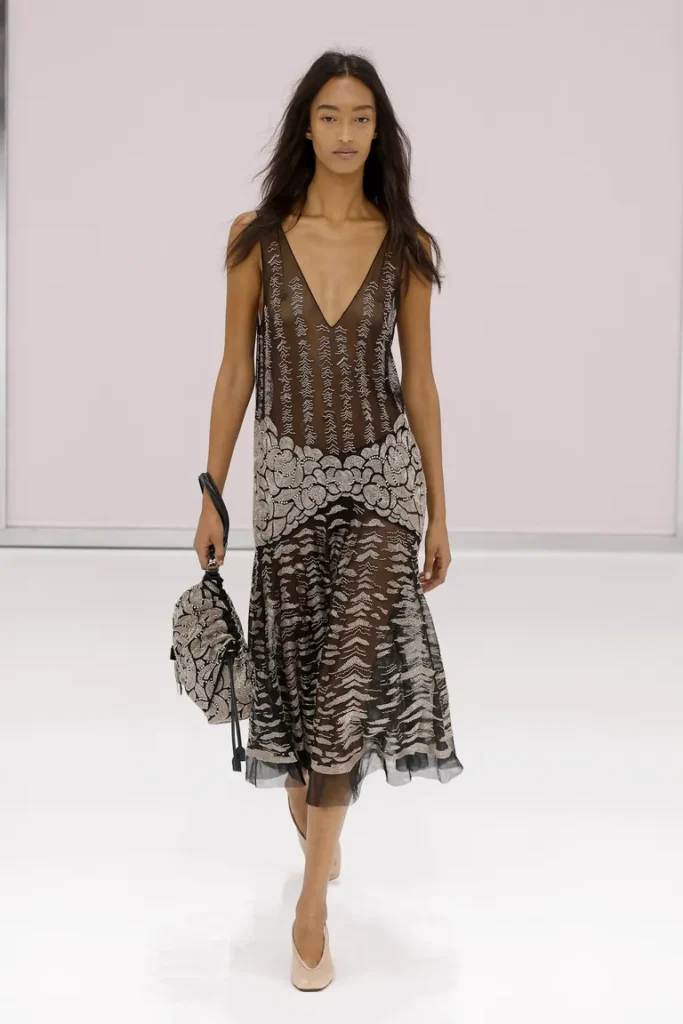
Kim Jones’ most recent ready-to-wear collection for the Roman house was shown on a sizable set outside of Milan, since renovations are still ongoing at Fendi’s headquarters on Via Solari. The British designer sought to channel the free-spirited modernity of the 1920s with a feminine collection that featured delicate, flapper-inspired dresses, sinuous sheer layers and flourishes of crystal embellishment. The brand is celebrating its centenary year this year, having been founded in 1925 as a leather goods manufacturer. Jones claimed that the intricate craft on display was a bridge to his couture collections for the house, which extended all the way to crystal-decorated pop socks.
The almost sci-fi white runway backdrop, focused around a massive box that, in a final surprise, opened to reveal a shimmering tableau of models inside, stood in stark contrast to the leisurely splendour.
The 1920s laid the groundwork for modern women’s fashion as well as, to a large extent, our way of thinking. Jones clarified, “It’s about modernity in style and attitude. 1925 also saw the publication of F. Scott Fitzgerald’s The Great Gatsby and Virginia Woolf’s Mrs. Dalloway.” “There is a modernism in thought, design, clothing, and decoration.” Keeping these aspects in mind, we approached the collection as a fusion of then and now epochs, emotions, and styles.
The soundtrack, which featured excerpts of a conversation between house scions Anna and Silvia Fendi (the latter also serving as artistic director of accessories and menswear), about Adele Fendi, who founded Fendi with her husband Edoardo, was a reflection of this mixing of eras. The song featured a soaring Max Richter composition. “I was looking for something romantic, something from the 2020s that had a nod to the 1920s,” Jones remarked. It was a leap between eras, and the result was maybe his best-ever Fendi assortment.


